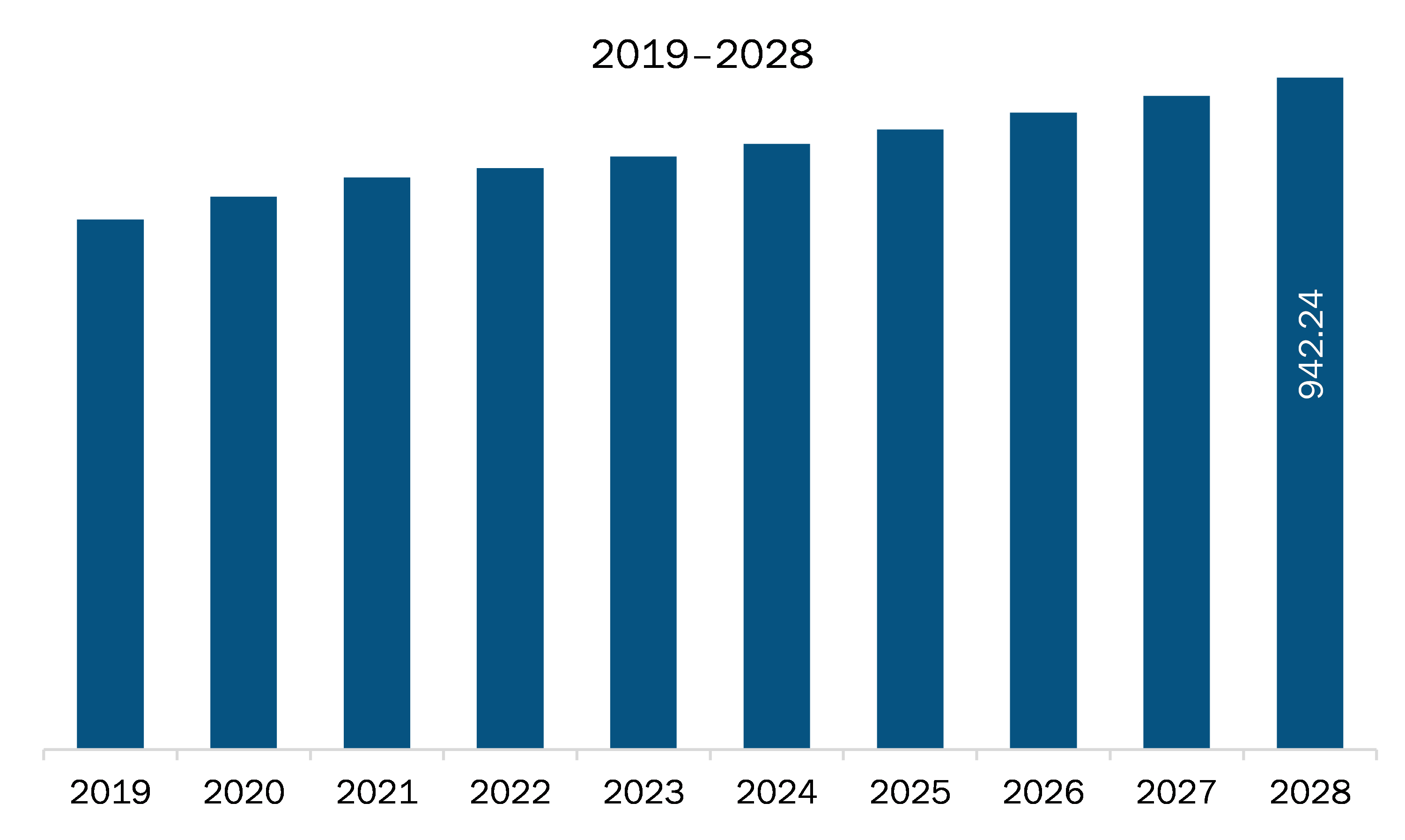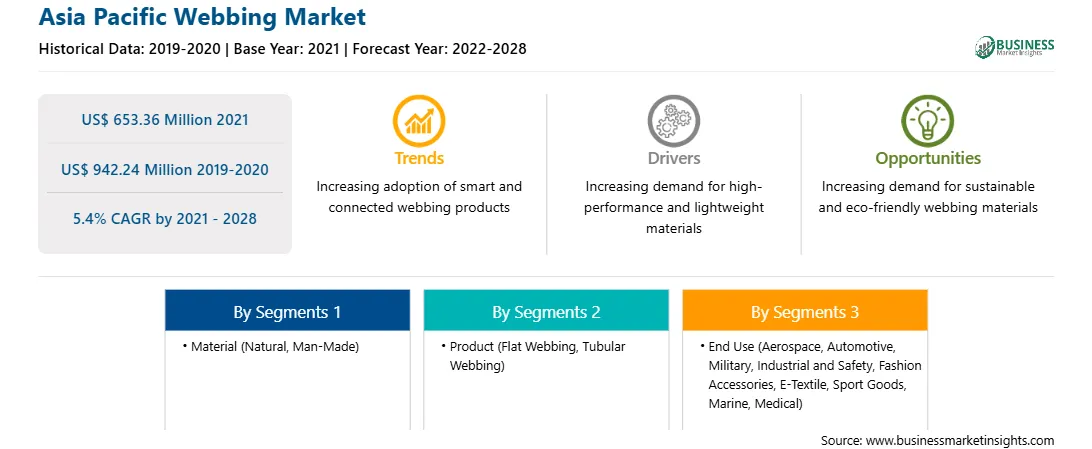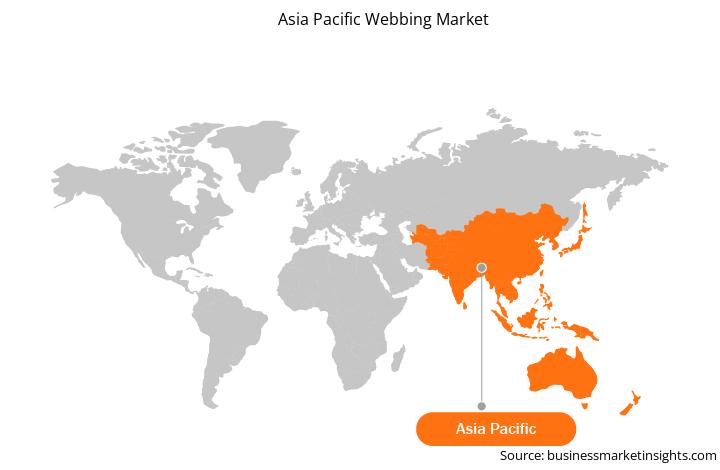The Asia Pacific webbing market is a highly fragmented market with the presence of considerable regional and local players providing numerous solutions for companies investing in the market arena. The demand for environment-friendly fabric material has been increasing with the rising concerns related to environment degradation and waste management coupled with growing focus on the deployment of sustainable materials. The demand for such materials is strongly driven by stringent government regulations on the use of nonbiodegradable webbing materials due to the adverse impacts of such material. With growing focus toward eco-friendly webbing materials, manufacturers have come up with new materials such as recycled polyester, bamboo webbing, wool webbing, rayon webbing, soy webbing, organic cotton webbing, linen webbing, jute webbing, and hemp webbing. Such webbing materials have comparatively less pH value, which makes them ideal to be used in textile materials. This type of webbing material does not cause skin itching and does not damage the weak acidic environment of the skin surface. Also, the materials do not use disperse dyes, which may cause allergies. The increasing investments by manufacturers in R&D activities for the development of environment-friendly and performance-efficient webbing materials would drive the growth of the webbing market in coming years.
In case of COVID-19, in Asia Pacific, especially India, witnessed an unprecedented rise in number of coronavirus cases, which led to the discontinuation of webbing manufacturing activities. Downfall of other chemical and materials manufacturing sectors has negatively impacted the demand for webbing during the early months of 2020. Moreover, decline in the overall fiber and composites manufacturing activities has led to discontinuation of webbing manufacturing projects, thereby reducing the demand for webbing. Similar trend was witnessed in other Asia Pacific countries, i.e., Japan, China and Australia. However, the countries are likely to overcome thus drop in demand with the economic activities regaining their pace, especially in the beginning of the 2021.

Strategic insights for the Asia Pacific Webbing provides data-driven analysis of the industry landscape, including current trends, key players, and regional nuances. These insights offer actionable recommendations, enabling readers to differentiate themselves from competitors by identifying untapped segments or developing unique value propositions. Leveraging data analytics, these insights help industry players anticipate the market shifts, whether investors, manufacturers, or other stakeholders. A future-oriented perspective is essential, helping stakeholders anticipate market shifts and position themselves for long-term success in this dynamic region. Ultimately, effective strategic insights empower readers to make informed decisions that drive profitability and achieve their business objectives within the market.

| Report Attribute | Details |
|---|---|
| Market size in 2021 | US$ 653.36 Million |
| Market Size by 2028 | US$ 942.24 Million |
| Global CAGR (2021 - 2028) | 5.4% |
| Historical Data | 2019-2020 |
| Forecast period | 2022-2028 |
| Segments Covered |
By Material
|
| Regions and Countries Covered | Asia-Pacific
|
| Market leaders and key company profiles |
The geographic scope of the Asia Pacific Webbing refers to the specific areas in which a business operates and competes. Understanding local distinctions, such as diverse consumer preferences (e.g., demand for specific plug types or battery backup durations), varying economic conditions, and regulatory environments, is crucial for tailoring strategies to specific markets. Businesses can expand their reach by identifying underserved areas or adapting their offerings to meet local demands. A clear market focus allows for more effective resource allocation, targeted marketing campaigns, and better positioning against local competitors, ultimately driving growth in those targeted areas.

The webbing market in Asia Pacific is expected to grow from US$ 653.36 million in 2021 to US$ 942.24 million by 2028; it is estimated to grow at a CAGR of 5.4% from 2021 to 2028. Asia Pacific has emerged as one of the lucrative regions for webbing market. Further, the shift in consumer lifestyle has bolstered the demand for several industrial and nonindustrial products, which is driving the demand for webbing in the economy. The region encompasses an ample number of opportunities for the growth of the market owing to the rapid industrial development along with significant rise in foreign direct investments and increase in expenditure toward research and development activities, which are altogether expected to diversify the application base of webbing in coming years. China is dominating the regional market, followed by other countries such as Japan, India, Vietnam, Korea, Thailand, Malaysia, and Indonesia. For instance, as per an article published in People's Daily Online, China's sports industry grew by 11.6% in 2019. In 2019, the year-on-year size of China's sports industry increased by 10.9%. Similarly, the sports industry in India grew up by 15% in 2019, according to DataPOWA with a considerable increment over the Asia Pacific average of 5%. Hence, the growth of sports industry is expected to promote the demand for webbing in Asian market.
Based on material, the man-made segment accounted for the largest share of the Asia Pacific webbing market in 2020. Based on product, the flat webbing segment accounted for the largest share of the Asia Pacific webbing market in 2020. Based on product, the automotive segment accounted for the largest share of the Asia Pacific webbing market in 2020.
A few major primary and secondary sources referred to for preparing this report on the Asia Pacific webbing market are company websites, annual reports, financial reports, national government documents, and statistical database, among others. Major companies listed in the report include E. Oppermann GmbH; Narrowtex Australia; National Webbing Products Co. and Tennessee Webbing Products.
The Asia Pacific Webbing Market is valued at US$ 653.36 Million in 2021, it is projected to reach US$ 942.24 Million by 2028.
As per our report Asia Pacific Webbing Market, the market size is valued at US$ 653.36 Million in 2021, projecting it to reach US$ 942.24 Million by 2028. This translates to a CAGR of approximately 5.4% during the forecast period.
The Asia Pacific Webbing Market report typically cover these key segments-
The historic period, base year, and forecast period can vary slightly depending on the specific market research report. However, for the Asia Pacific Webbing Market report:
The Asia Pacific Webbing Market is populated by several key players, each contributing to its growth and innovation. Some of the major players include:
The Asia Pacific Webbing Market report is valuable for diverse stakeholders, including:
Essentially, anyone involved in or considering involvement in the Asia Pacific Webbing Market value chain can benefit from the information contained in a comprehensive market report.